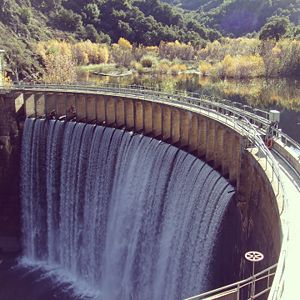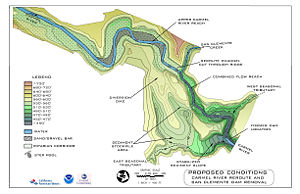Difference between revisions of "San Clemente Dam"
(→Threatened Species) |
m (→Seismic Considerations) |
||
| Line 13: | Line 13: | ||
===Seismic Considerations=== | ===Seismic Considerations=== | ||
| − | Located near the Tularcitos fault, the San Clemente Dam is vulnerable a catastrophic failure due to an earthquake. With the dam having reached its expected useful life and with 1500 homes below the dam under threat, in 2006 the California Department of Water Resources decided that action had to be taken | + | Located near the Tularcitos fault, the San Clemente Dam is vulnerable a catastrophic failure due to an earthquake. With the dam having reached its expected useful life and with 1500 homes and otehr structures below the dam under threat, in 2006 the California Department of Water Resources decided that action had to be taken to mitigate the danger by either removing or reinforcing the dam. |
===Threatened Species=== | ===Threatened Species=== | ||
Revision as of 22:25, 28 March 2013
This page gives a short history of the San Clemente Dam and description of the planned dam removal project and its environmental impact and related issues and controversies.
Contents
History
The San Clemente Dam was built in 1921 by a local businessman Samuel Morse on the Carmel River to supply the water needs of Monterey's growing population and tourism industry. Later the dam was purchased by Chester Loveland who owned the California Water and Telephone Company (CW&T). To meet the needs of the growing population and increasing demand from the sardine processing industry in Monterey, CW&T built the Los Padres Dam upstream from San Clemente Dam in 1948. In 1966 CW&T sold the dam to California American Water for $42 million. [1] [2] [3].
Geology and Ecology of Carmel River Watershed
Geology and Sedimentation
The Carmel River watershed is on a highly erodable geological formation (filler to be flushed out). Although the dam was built in 1921, by 1947 it was 25% silted and is now 98% silted. Cite error: Closing </ref> missing for <ref> tag .
Seismic Considerations
Located near the Tularcitos fault, the San Clemente Dam is vulnerable a catastrophic failure due to an earthquake. With the dam having reached its expected useful life and with 1500 homes and otehr structures below the dam under threat, in 2006 the California Department of Water Resources decided that action had to be taken to mitigate the danger by either removing or reinforcing the dam.
Threatened Species
There are two threatened species in the Carmel River and Watershed that will be impacted by the dam removal process.
- The Central Coast steelhead trout population endemic to the Carmel River are within the South-Central California Coast (SCCC) Evolutionarily Significant Unit (ESU). The SCCC ESU has been classified as "threatened". The California Department of Fish and Game (CDFG) is responsible for managing and maintaining a healthy steelhead population and are working on restoration of the population to historic levels on the Carmel River. [4]
- California red-legged frog
Dam Removal
The San Clemente Dam is set to be removed from 2013 - 2015 due to public safety hazards that could occur in the event of an earthquake or flood in the area.
Reasons for Dam Removal
In the 1990s, California Department of Water Resources (DWR) Division of the Safety of Dams(DSOD) issued a safety order which determined that in the event of the maximum credible earthquake or probable maximum flood the dam would potentially fail creating a public safetly issue [5]. After this report the San Clemente Dam was listed as a high priority public safety issue. An Environmental Impact Report was undertaken to explore the best method for addressing the public safety issues. In 2006 the DWR released a Draft Environmental Impact Report/Environmental Impact Statement (EIR/EIS). The EIR explored CalAm's preferred option of strengthening the Dam and four alternative projects, including the Carmel River Reroute and Dam Removal (CRRDR) option. The CRRDR option had several ecological benefits that the Dam Strengthening option did not have. In 2008 the DSOD stated the CRRDR project would address the dam's public safety issues and other environmental impacts caused by the dam making it the best option for all stakeholders [6].
Carmel River Reroute and Dam Removal (CRRDR) Project:
The Carmel River Reroute and Dam Removal (CRRDR) will provide several benefits for the Carmel River including:
- Permanent resolution to the dam safety concern
- Access for endangered steelhead trout to 25+ miles of spawning and rearing habitat
- Restoration of sediment to the downstream reach of the river and Carmel River State Beach
- Restored ecological connectivity for riparian and aquatic habitats
Project
In order to carry out the CRRDR, access roads are being constructed off of Carmel Valley Road after Carmel Valley Village and before the Sleepy Hollow turn-off. Once the access roads are completed CRRDR construction can begin.The Carmel river will be rerouted into the adjacent San Clemente Creek a half mile upstream of the dam by cutting a diversion channel through a narrow ridge separating the two channels. The rock created by the diversion channel will be used to block the sedimented reach of Carmel and divert the river into the San Clemente reach. This rock barrier, known as a diversion dike, will essentially create a new ridge along the valley floor cutting off the Upper Carmel reach that is full of sediment. Sediment that has accumulated in the San Clemente reach will be excavated and moved to the Upper Carmel reach. The Sediment that has accumulated directly be hind the dam will also need to be excavated and transferred to the Upper Carmel reach. After the sediment has been excavated and placed upstream of the dam, the sediment slope will be stabilized to stabilize the sediment from being eroded during high flows.
After the sediment has been excavated and stabilized, the San Clemente reach of the river downstream of the diversion dike will be restored by implementing step pools. The restoration will create a riparian corridor and seasonal ponds that can be used as habitat for California red-legged frogs. After the stream restoration, the San Clemente Dam and fish latter will be be removed. Once the dam and fish latter have been removed, the Old San Clemente Dam (1800 ft downstream) will be notched to improve steelhead passage and the overall river stability.
Timeline
As of March 2013, construction is set to begin in 2013, and the estimated completion is set for 2015. Access roads are under construction at this time.
Stakeholders
References
- ↑ CalAm page http://www.amwater.com/caaw/customer-service/rates-information/monterey-san-clemente-dam-removal-project.html
- ↑ History - "Water Over the Dam" by Keith Vandevere http://www.kiracorser.com/ecoart/history/time.htm
- ↑ Carmel Vally Association "Carmel River History"
- ↑ Final Supplement to the Environmental Impact Report: San Clemente Dam Seismic Safety Project environmental impact report
- ↑ San Clemente Dam Removal Project Summary
- ↑ San Clemente Dam Removal Project Summary
Links
Disclaimer
This page may contain students's work completed as part of assigned coursework. It may not be accurate. It does not necessarily reflect the opinion or policy of CSUMB, its staff, or students.


